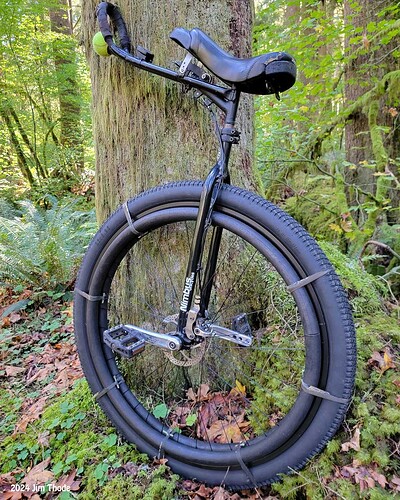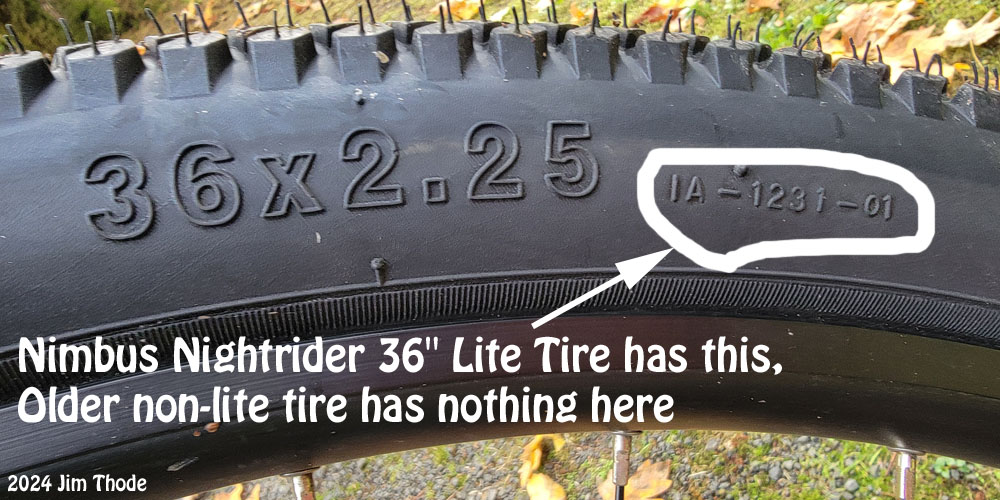Some unicyclist go to great effort and expense to reduce the weight of the unicycle wheel. But is less weight really better for normal use? Just for the fun of it, I added 10.5 lbs (4.8kg) to my 36er wheel. The current Nightrider tire weighs 2.9lbs (1.5kg), that makes my tire and added weight about 3.5 times more then a “normal”36er tire. Changing from an aluminum rim to a carbon fiber rim reduces the wheel weight by about 1.3 lbs (600g). I would think if reducing the wheel weight by 1.3 lbs makes a huge positive difference in unicycle performance, then adding 10.5 lbs would have an enormous negative affect on performance. I did not find that to be the case.
Anyone that has reduced the wheel weight will immediacy notice that the uni feels more responsive and quicker to get up to speed. Sometimes it is helpful to push things outside of the normal range to clearly identify the advantages and disadvantaged of the issue. I have seen many riders working to reduce the wheel weight but there is a limit to how much weight can be removed. On the other hand there is no real limit on how much weight can be added and my testing may help to identify the advantages and disadvantages of wheel weight.
The weight I added can be installed and removed in a couple minutes so it is quite easy to evaluate the difference in handling that the weight causes. I used some very thick walled heavy rubber tubing for the weight and it is attached with inner tube bungees.
I rode about 20 miles (32km) with the worlds heaviest 36” uni wheel and my impressions are:
- The added weight makes it easier to mount, the wheel is more stable and less likely to roll during mounting.
- The added weight makes it slower/harder to get up to speed. This added effort is not wasted, it is just energy stored in the wheel’s rotation. This added effort to get up to speed accounts for about 0.5% of my normal ride time.
- The heavier wheel results in less wheel wobble when riding. This accounts for 99.5% of my normal ride time.
- The heavier wheel rolls over bumps and dips easier with less chance of a UPD.
- The heavier wheel provides a more relaxed and more energy efficient ride because there is significantly less need to correct for forward and backward balance. The added wheel weight essentially eliminates the need to apply any pressure on the pedal’s upward stroke. Any correction of balance that requires pushing on the pedal as it moves up is wasted energy. This added benefit accounts for 99.5% of my normal ride time.
- The approximately 5% increase in total unicycle plus rider weight is not noticeable but does cause a slight increase in rolling resistance. This increase in rolling resistance can be easily eliminated by increasing the tire pressure a little.
- The unicycle corners more uniformly and less jerky with the added weight.
- My ride included a total elevation gain of about 600ft (182m). I did not notice the added weight.
- The maximum grade on my ride was 12% grade (with 109mm cranks). I did not notice the added effort but did notice the smoother more uniform force to ride up a bumpy incline. I did not notice the required additional braking required on the downhill grade but did notice the more uniform speed and less need to correct for forward and backward balance on the down hill grade.
- Because the added weight is close to the vertical axis of rotation there is a small but noticeable affect on the ability to make sharp turns or pivots.
- The added weight would very likely make some tricks like one foot riding and freewheeling easier and other tricks like high jumping harder. I don’t normally do tricks on my 36er.
My conclusion;
For sprint racing on a smooth surface and some tricks a lighter wheel is an advantage. For normal road touring, mounting and riding over rough surfaces a heavier wheel is an advantage. Because of the cumbersome nature of adding weight I will not leave the weight on my 36er and will definitely not go to any expense or effort to reduce the weight of my wheel either.

